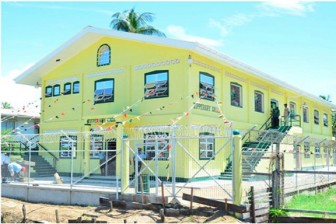Residents of Buxton are hoping that the commissioning of the 21st century Tipperary Hall last Thursday will revive the many social activities that were once common in the community and that partnership with the government that led to the restoration of the facility will continue, a press release from the Government Information Agency stated.
The cutting of the ribbon, unveiling of the plaque, and symbolic handover of the keys by President Ramotar, steel pan renditions by musicians from the community, and the singing of the “Buxton Battle Song” highlighted the historic occasion.
According to GINA, the promise of a new building dates back to what many regard as a historic visit by former President Bharrat Jagdeo in 2010, that was part of a mission to restore pride in the East Coast Demerara community.

Elders like Charles, who is knowledgeable on the history of the facility, said it has its genesis in a request made by his mother to former President Janet Jagan during a visit to the community.
First built in 1909, and registered in 1911, Tipperary Hall, on Middle Walk, Buxton, is replete with history as a hub for a variety of community activities, including political meetings.
While many are looking to the facility for a revival of the same pride in the community, President Ramotar is anticipating greater contributions to nation building with today’s generation meaningfully involved.
“It must also now take on the role of educating the young people in this community. We must have educational classes here, we must train our young people to use computers, we must train our young people to understand all the new tools that they have to work with in the future,” President Ramotar was quoted as saying.
The Tipperary Hall Management Committee, which worked in partnership with the government on the restoration of the building, has already outlined a plan that will see meaningful activities targeting youth empowerment.
The idea was fully endorsed by President Ramotar, who maintains the view that most progressive economies of today are those with a highly educated population.
“I hope that the investment that has been made here by a combination of community and government efforts, will fulfil this role of building a high quality of persons who will be capable of transforming their community, and in the process, make a contribution to the transformation of our country,” President Ramotar said.
The restoration process saw several engagements between the government and members of the community, GINA noted.
In October, 2010, the design for the building was ratified by the community and approved by the government. A copy of the design showed a two-storeyed building with modern amenities, such as a library, an office, classrooms for computer training, a lavatory block, an auditorium with a stage, a changing room and a bar. The sod to the $50M edifice was turned by former President Jagdeo in December 2010.
The bottom flat of the building is still to be outfitted with the requisite amenities, but in the interim, the committee is looking to broaden its membership so that the facility is available to the wider community in a meaningful way.
“We must use institutions and edifices like these to understand each other better, to understand what our cultures stand for, our traditions, our ceremonies, religious or otherwise, and I’m sure that if we take some time off to look at these things, you will see that there is far more that unites us than divides us,” Ramotar noted.





